Characteristics of Dissolved Organic Nitrogen in the Sediments of Six Water Sources in Taihu Lake, China
Abstract
:1. Introduction
2. Material and Methods
2.1. Study Site
2.2. Sampling Position
2.3. Sample Collection and Pretreatment
2.4. Sample Analysis
2.4.1. KS-DON Analysis
2.4.2. Molecular Weight Fractionation
2.4.3. Hydrophilic and Hydrophobic Fractionation
2.4.4. EEM Fluorescence Spectroscopy Determination and Analysis
2.5. Data Analysis
3. Results and Discussion
3.1. Sediment Nitrogen Species and Concentrations
3.2. Molecular Weight Fractionations of KS-DON
3.3. Hydrophilic and Hydrophobic Fractions of KS-DON
3.4. Fluorescence Characteristics of KS-DON
3.5. Possible Management Approaches on Reduction the Risk of Endogenous N Release
3.5.1. Ecological dredging
3.5.2. Establishment of constructed wetlands
4. Conclusions
Author Contributions
Funding
Conflicts of Interest
References
- Nowlin, W.H.; Evarts, J.L.; Vanni, M.J. Release Rates and Potential Fates of Nitrogen and Phosphorus From Sediments in a Eutrophic Reservoir. Freshw. Biol. 2010, 50, 301–322. [Google Scholar] [CrossRef]
- Berman, T.; Chava, S. Algal Growth on Organic Compounds as Nitrogen Sources. J. Plankton Res. 1999, 21, 1423–1437. [Google Scholar] [CrossRef]
- Holst, J.; Brackin, R.; Robinson, N. Soluble inorganic and organic nitrogen in two Australian soils under sugarcane cultivation. Agric. Ecosyst. Environ. 2012, 155, 16–26. [Google Scholar] [CrossRef]
- Antia, N.J.; Harrison, P.J.; Oliveira, L.; Anita, N.J.; Harrison, P.J.; Oliveira, L. The role of dissolved organic nitrogen in phytoplankton nutrition, cell biology and ecology. Phycologia 1991, 30, 1–89. [Google Scholar] [CrossRef]
- Kemp, A.L.W.; Mudrochova, A. Distribution and forms of nitrogen in a lake ontrario sediment core. Limnol. Oceanogr. 1972, 17, 855–867. [Google Scholar] [CrossRef]
- Lin, S.; Wang, S.; Jin, X.A.; Xingcun, H.E. Contents and distribution characteristics of soluble organic nitrogen in surface sediments of lakes. J. Lake Sci. 2009, 21, 623–630. [Google Scholar]
- Lovett, G.M.; Weathers, K.C.; Arthur, M.A. Control of Nitrogen Loss from Forested Watersheds by Soil Carbon: Nitrogen Ratio and Tree Species Composition. Ecosystems 2002, 5, 712–718. [Google Scholar] [CrossRef]
- Hu, H.; Liao, K.; Geng, J.; Xu, K.; Huang, H.; Wang, J.; Ren, H. Removal Characteristics of Dissolved Organic Nitrogen and Its Bioavailable Portion in a Postdenitrifying Biofilter: Effect of the C/N Ratio. Environ. Sci. Technol. 2018, 52, 7b–5115b. [Google Scholar] [CrossRef]
- Hu, H.; Jiang, C.; Ma, H.; Ding, L.; Geng, J.; Xu, K.; Huang, H.; Ren, H. Removal characteristics of DON in pharmaceutical wastewater and its influence on the N -nitrosodimethylamine formation potential and acute toxicity of DOM. Water Res. 2016, 109, 114. [Google Scholar] [CrossRef]
- Elif, P.M.; Sedlak, D.L. Measurement of dissolved organic nitrogen forms in wastewater effluents: Concentrations, size distribution and NDMA formation potential. Water Res. 2008, 42, 3890–3898. [Google Scholar]
- Ji, J.Y.; Xing, Y.J.; Ma, Z.T.; Cai, J.; Zheng, P.; Lu, H.F. Toxicity assessment of anaerobic digestion intermediates and antibiotics in pharmaceutical wastewater by luminescent bacterium. J. Hazard. Mater. 2013, 246, 319–323. [Google Scholar] [CrossRef] [PubMed]
- Zhang, L.; Wang, S.; Zhao, H.; Li, Y.; Huo, S.; Qian, W.; Yang, Y.; Cheng, J. Using multiple combined analytical techniques to characterize water extractable organic nitrogen from Lake Erhai sediment. Sci. Total Environ. 2016, 542, 344–353. [Google Scholar] [CrossRef]
- Derrien, M.; Lee, Y.K.; Shin, K.; Hur, J. Comparing discrimination capabilities of fluorescence spectroscopy versus FT-ICR-MS for sources and hydrophobicity of sediment organic matter. Environ. Sci. Pollut. Res. 2018, 25, 1892–1902. [Google Scholar] [CrossRef]
- Zhai, T.; Zhang, J.; Huo, S.; Xi, B.; Su, M.; Ma, C.; He, Z.; Su, J. Algal activity of dissolved organic nitrogen (DON) in the sediments of Lake Taihu, Eastern China. Environ. Earth Sci. 2016, 75, 1496. [Google Scholar] [CrossRef]
- Wang, S.; Zhao, Y.; Jiao, L.; Zhang, L.; Guo, W. Characteristics of soluble organic nitrogen composition and sources in sediments from Erhai Lake in China and the effect on the water quality. Environ. Earth Sci. 2015, 74, 3849–3856. [Google Scholar] [CrossRef]
- Tao, H.; Feng, B.; Chen, W.; Hua, W.; Zhao, S.J. Behavior of dissolved organic nitrogen in sediment. Fresenius Environ. Bull. 2014, 23, 908–914. [Google Scholar]
- Shi, L.L.; Zhang, L.; Wang, S.R.; Duan, C.Q.; Li, W.Z.; Xi, Y.; Li, Q.C.; Xu, K.C. Releasing Characteristics of Sediment Dissolved Organic Nitrogen (DON) from Erhai Lake and its environmental impact mechanism. China Environ. Sci. 2017, 37, 2715–2722. [Google Scholar]
- Lomstein, B.A.; Jensen, A.; Hansen, J.W.; Andreasen, J.B.; Hansen, L.S.; Berntsen, J.; Kunzendorf, H. Budgets of sediment nitrogen and carbon cycling in the shallow water of Knebel Vig, Denmark. Aquat. Microb. Ecol. 1998, 14, 69–80. [Google Scholar] [CrossRef]
- Nawrocki, J. Nitrosamines—Troublesome by-products of water disinfection. Ochr. Śr. 2007, 29, 13–18. [Google Scholar]
- Schreiber, I.M.; Mitch, W.A. Occurrence and fate of nitrosamines and nitrosamine precursors in wastewater-impacted surface waters using boron as a conservative tracer. Environ. Sci. Technol. 2006, 40, 3203–3210. [Google Scholar] [CrossRef] [PubMed]
- Xu, B.; Li, D.P.; Li, W.; Xia, S.J.; Lin, Y.L.; Hu, C.Y.; Zhang, C.J.; Gao, N.Y. Measurements of dissolved organic nitrogen (DON) in water samples with nanofiltration pretreatment. Water Res. 2010, 44, 5376–5384. [Google Scholar] [CrossRef] [PubMed]
- Richardson, S.D.; Plewa, M.J.; Wagner, E.D.; Schoeny, R.; Demarini, D.M. Occurrence, genotoxicity, and carcinogenicity of regulated and emerging disinfection by-products in drinking water: A review and roadmap for research. Mt. Res./Fundam. Mol. Mech. Mutagen. 2007, 636, 178–242. [Google Scholar] [CrossRef] [PubMed]
- Bing, L.; Li, G.; Xin, Y.; Yu, G.; Zhang, H.; Xu, J. Dissolved organic nitrogen (DON) profile during backwashing cycle of drinking water biofiltration. Sci. Total Environ. 2012, 414, 508–514. [Google Scholar]
- Chen, J.; Xie, P.; Ma, Z.; Niu, Y.; Tao, M.; Deng, X.; Wang, Q. A systematic study on spatial and seasonal patterns of eight taste and odor compounds with relation to various biotic and abiotic parameters in Gonghu Bay of Lake Taihu, China. Sci. Total Environ. 2010, 409, 314–325. [Google Scholar] [CrossRef] [PubMed]
- Niu, X.; Geng, J.; Wang, X.; Wang, C.; Gu, X.; Edwards, M.; Glindemann, D. Temporal and spatial distributions of phosphine in Taihu Lake, China. Sci. Total Environ. 2004, 323, 169–178. [Google Scholar] [CrossRef] [PubMed]
- Trolle, D.; Zhu, G.; Hamilton, D.; Luo, L.; Mcbride, C.; Zhang, L. The influence of water quality and sediment geochemistry on the horizontal and vertical distribution of phosphorus and nitrogen in sediments of a large, shallow lake. Hydrobiologia 2009, 627, 31–44. [Google Scholar] [CrossRef]
- Han, H.; Li, Z. Effects of macrophyte-associated nitrogen cycling bacteria on ANAMMOX and denitrification in river sediments in the Taihu Lake region of China. Ecol. Eng. 2016, 93, 82–90. [Google Scholar] [CrossRef]
- Xu, S.; Huang, B.; Wei, Z.; Luo, J.; Miao, A.; Yang, L. Seasonal variation of phytoplankton nutrient limitation in Lake Taihu, China: A monthly study from Year 2011 to 2012. Ecotoxicol. Environ. Saf. 2013, 94, 190–196. [Google Scholar] [CrossRef]
- Hagedorn, C.; Liang, X. Current and future trends in fecal source tracking and deployment in the Lake Taihu Region of China. Phys. Chem. Earth Parts A/B/C 2011, 36, 352–359. [Google Scholar] [CrossRef]
- Tang, X.; Ullah, N.; Yu, C.; Qin, Z.; Huang, R.; Zhu, X.; Shen, C.; Chen, Y. Chemical and Bioassay Analysis of Estrogen Pollution in the Surface Water of the Tiaoxi River, the Source River for Taihu Lake. Bull. Environ. Contam. Toxicol. 2012, 89, 816–819. [Google Scholar] [CrossRef]
- Xiaolong, Y.; Lu, Z.; Yunlin, Z.; Bo, Z.; Zhonghua, Z.; Yibo, Z.; Min, L.; Xingyu, J. Nitrogen Fixation Occurring in Sediments: Contribution to the Nitrogen Budget of Lake Taihu, China. J. Geophys. Res. Biogeosci. 2018, 123, 2661–2674. [Google Scholar]
- Yang, Z.; Zhang, M.; Shi, X.; Kong, F.; Ma, R.; Yu, Y. Nutrient reduction magnifies the impact of extreme weather on cyanobacterial bloom formation in large shallow Lake Taihu (China). Water Res. 2016, 103, 302–310. [Google Scholar] [CrossRef]
- Huo, S.; Zhang, J.; Yeager, K.M.; Xi, B.; Qin, Y.; He, Z.; Wu, F. Mobility and sulfidization of heavy metals in sediments of a shallow eutrophic lake, Lake Taihu, China. J. Environ. Sci. 2015, 31, 1–11. [Google Scholar] [CrossRef]
- Hongtao, D.; Ronghua, M.; Xiaofeng, X.; Fanxiang, K.; Shouxuan, Z.; Weijuan, K.; Jingyan, H.; Linlin, S. Two-decade reconstruction of algal blooms in China’s Lake Taihu. Environ. Sci. Technol. 2012, 43, 3522–3528. [Google Scholar]
- Luo, J.; Li, X.; Ma, R.; Li, F.; Duan, H.; Hu, W.; Qin, B.; Huang, W. Applying remote sensing techniques to monitoring seasonal and interannual changes of aquatic vegetation in Taihu Lake, China. Ecol. Indic. 2016, 60, 503–513. [Google Scholar] [CrossRef]
- Paerl, H.W.; Otten, T.G. Blooms Bite the Hand That Feeds Them. Science 2013, 342, 433–434. [Google Scholar] [CrossRef]
- Juan, Y.I.; Feng, X.U.; Gao, Y.; Xiang, L.; Mao, X. Variations of water quality of the major 22 inflow rivers since 2007 and impacts on Lake Taihu. J. Lake Sci. 2016, 28, 1167–1174. [Google Scholar] [CrossRef]
- EPA of China. Water and Wastewater Monitoring Analysis Method, 4th ed.; Chinese Environment Science Publisher: Beijing, China, 2002.
- Huo, S.; Yu, H.; Xi, B.; Zan, F.; Zhu, C.; Zhang, J. Characteristics of dissolved organic nitrogen (DON) in the surface water of Beijing Olympic Forest Park. Environ. Earth Sci. 2014, 71, 1–8. [Google Scholar] [CrossRef]
- Yeh, Y.L.; Yeh, K.J.; Hsu, L.F.; Yu, W.C.; Lee, M.H.; Chen, T.C. Use of fluorescence quenching method to measure sorption constants of phenolic xenoestrogens onto humic fractions from sediment. J. Hazard. Mater. 2014, 277, 27–33. [Google Scholar] [CrossRef]
- Gray, S.R.; Ritchie, C.B.; Bolto, B.A. Effect of fractionated NOM on low-pressure membrane flux declines. Water Sci. Technol. Water Supply 2004, 4, 189–196. [Google Scholar] [CrossRef]
- Carroll, T.; King, S.; Gray, S.R.; Bolto, B.A.; Booker, N.A. The fouling of microfiltration membranes by NOM after coagulation treatment. Water Res. 2000, 34, 2861–2868. [Google Scholar] [CrossRef]
- Chen, W.; Westerhoff, P.; Leenheer, J.A.; Booksh, K. Fluorescence Excitation-Emission Matrix Regional Integration to Quantify Spectra for Dissolved Organic Matter. Environ. Sci. Technol. 2003, 37, 5701–5710. [Google Scholar] [CrossRef]
- Põder, T.; Maestrini, S.Y.; Balode, M.; Lips, U.; Béchemin, C.; Andrushaitis, A.; Purina, I. The role of inorganic and organic nutrients on the development of phytoplankton along a transect from the Daugava River mouth to the Open Baltic, in spring and summer 1999. ICES J. Mar. Sci. 2003, 60, 827–835. [Google Scholar]
- Owen, D.M.; Amy, G.L.; Chowdhury, Z.K.; Paode, R.; McCoy, G.; Viscosil, K. NOM: Characterization and treatability: Natural organic matter. J. Am. Water Works Assoc. 1995, 87, 46–63. [Google Scholar] [CrossRef]
- Bolto, B.A.; Dixon, D.R.; Eldridge, R.J.; King, S.J. The Use of Cationic Polymers as Primary Coagulants in Water Treatment; Springer: Berlin/Heidelberg, Germany, 1998; pp. 173–185. [Google Scholar]
- Wei, L.I.; Bin, X.U.; Xia, S.J.; Gao, N.Y.; Yan, L.; Liang, C. Review on Characteristics and Control of Dissolved Organic Nitrogen in Drinking Water. China Water Wastewater 2009, 25, 22–26. [Google Scholar]
- Wang, C.; Zhang, X.; Chen, W. Characterization of dissolved organic matter as N-nitrosamine precursors based on hydrophobicity, molecular weight and fluorescence. J. Environ. Sci. 2013, 25, 85–95. [Google Scholar] [CrossRef]
- Coble, P.G. Characterization of marine and terrestrial DOM in seawater using excitation-emission matrix spectroscopy. Mar. Chem. 1996, 51, 325–346. [Google Scholar] [CrossRef]
- Jie, C.; Leboeuf, E.J.; Sheng, D.; Gu, B. Fluorescence spectroscopic studies of natural organic matter fractions. Chemosphere 2003, 50, 639–647. [Google Scholar]
- Wu, F.; Tanoue, E. Isolation and partial characterization of dissolved copper-complexing ligands in streamwaters. Environ. Sci. Technol. 2001, 35, 3646–3652. [Google Scholar] [CrossRef]
- Su, M.; Zhang, J.; Huo, S.; Xi, B.; Hua, F.; Zan, F.; Qian, G.; Liu, J. Microbial bioavailability of dissolved organic nitrogen (DON) in the sediments of Lake Shankou, Northeastern China. J. Environ. Sci. 2016, 42, 79–88. [Google Scholar] [CrossRef]
- Qian, W.B.; Zhang, L.; Wang, S.R.; Cao, C.C.; Li, Y.P.; Cheng, J.; Yang, J.C.; Li, W.Z. Compositional characteristics of sediment dissolved organic nitrogen in typical lakes and its relationship on water trophic status. Spectrosc. Spectr. Anal. 2016, 36, 3164–3608. [Google Scholar]
- Wan, Y.; Bai, Y.; He, J.; Zhang, Y.; Li, R.; Ruan, X. Temporal and spatial variations of aquatic environmental characteristics and sediment bacterial community in five regions of Lake Taihu. Aquat. Ecol. 2017, 51, 343–358. [Google Scholar] [CrossRef]
- Li, Y.; Wang, S.; Zhang, L.; Zhao, H.; Jiao, L.; Zhao, Y.; He, X. Composition and spectroscopic characteristics of dissolved organic matter extracted from the sediment of Erhai Lake in China. J. Soils Sediments. 2014, 14, 1599–1611. [Google Scholar] [CrossRef]
- Liu, C.; Zhong, J.; Wang, J.; Zhang, L.; Fan, C. Fifteen-year study of environmental dredging effect on variation of nitrogen and phosphorus exchange across the sediment-water interface of an urban lake. Environ. Poll. 2016, 219, 639–648. [Google Scholar] [CrossRef]
- Liu, X.; Shi, C.; Xu, X.; Li, X.; Xu, Y.; Huang, H.; Zhao, Y.; Zhou, Y.; Shen, H.; Chen, C. Spatial distributions of β-cyclocitral and β-ionone in the sediment and overlying water of the west shore of Taihu Lake. Sci. Total Environ. 2017, 579, 430–438. [Google Scholar] [CrossRef]
- Tan, E.; Hsu, T.C.; Huang, X.; Lin, H.J.; Kao, S.J. Nitrogen transformations and removal efficiency enhancement of a constructed wetland in subtropical Taiwan. Sci. Total Environ. 2017, 601, 1378–1388. [Google Scholar] [CrossRef]
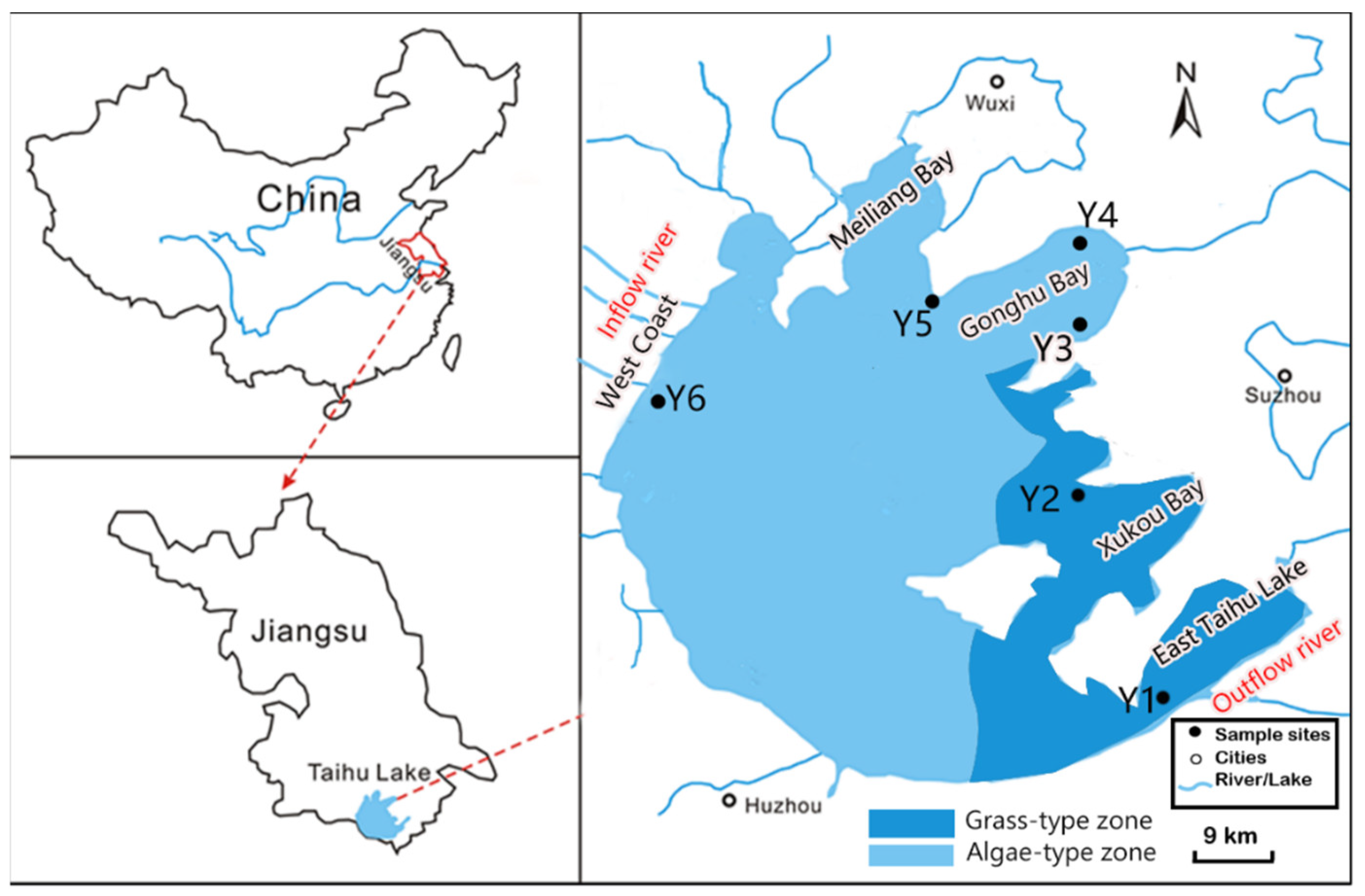
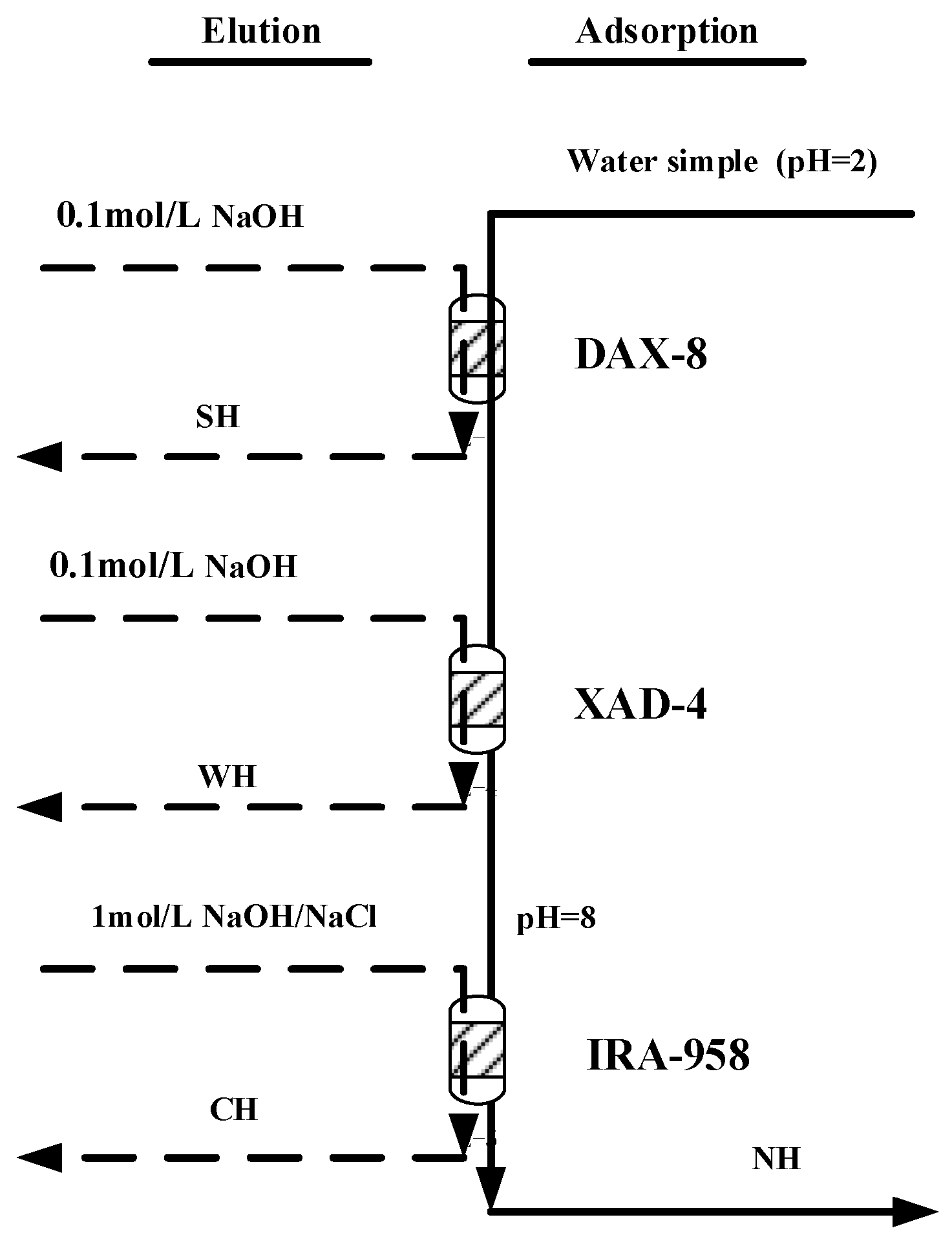
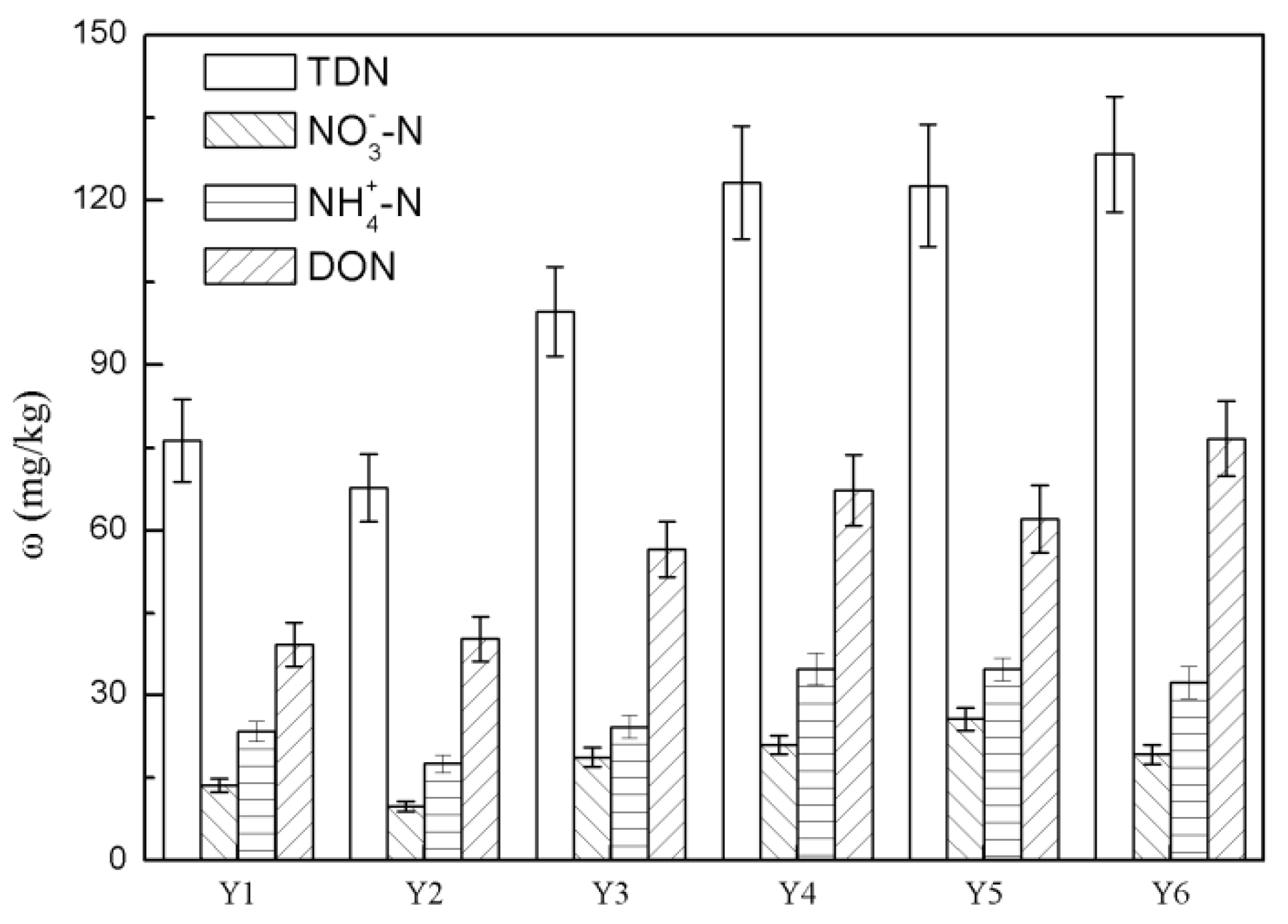
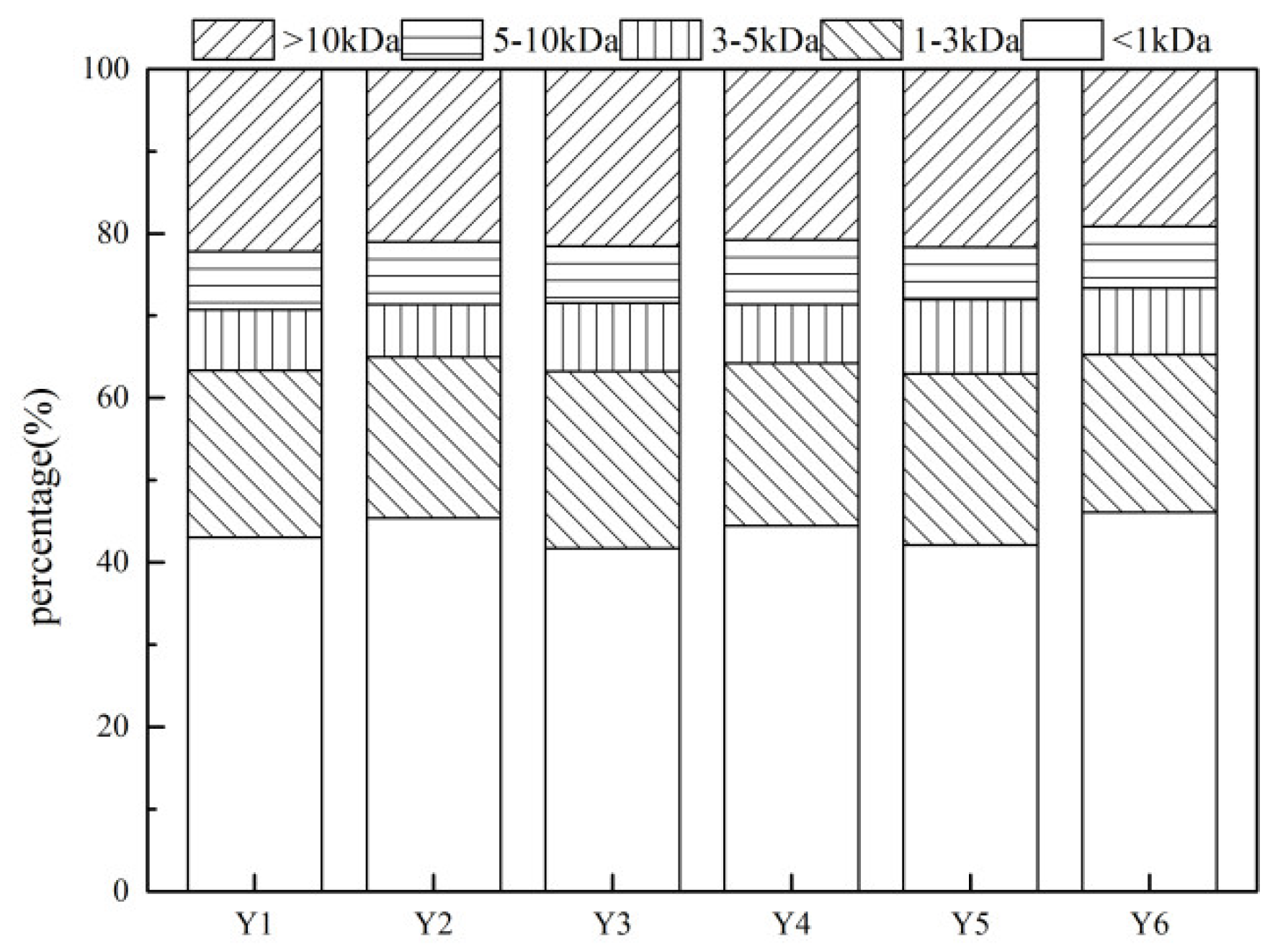
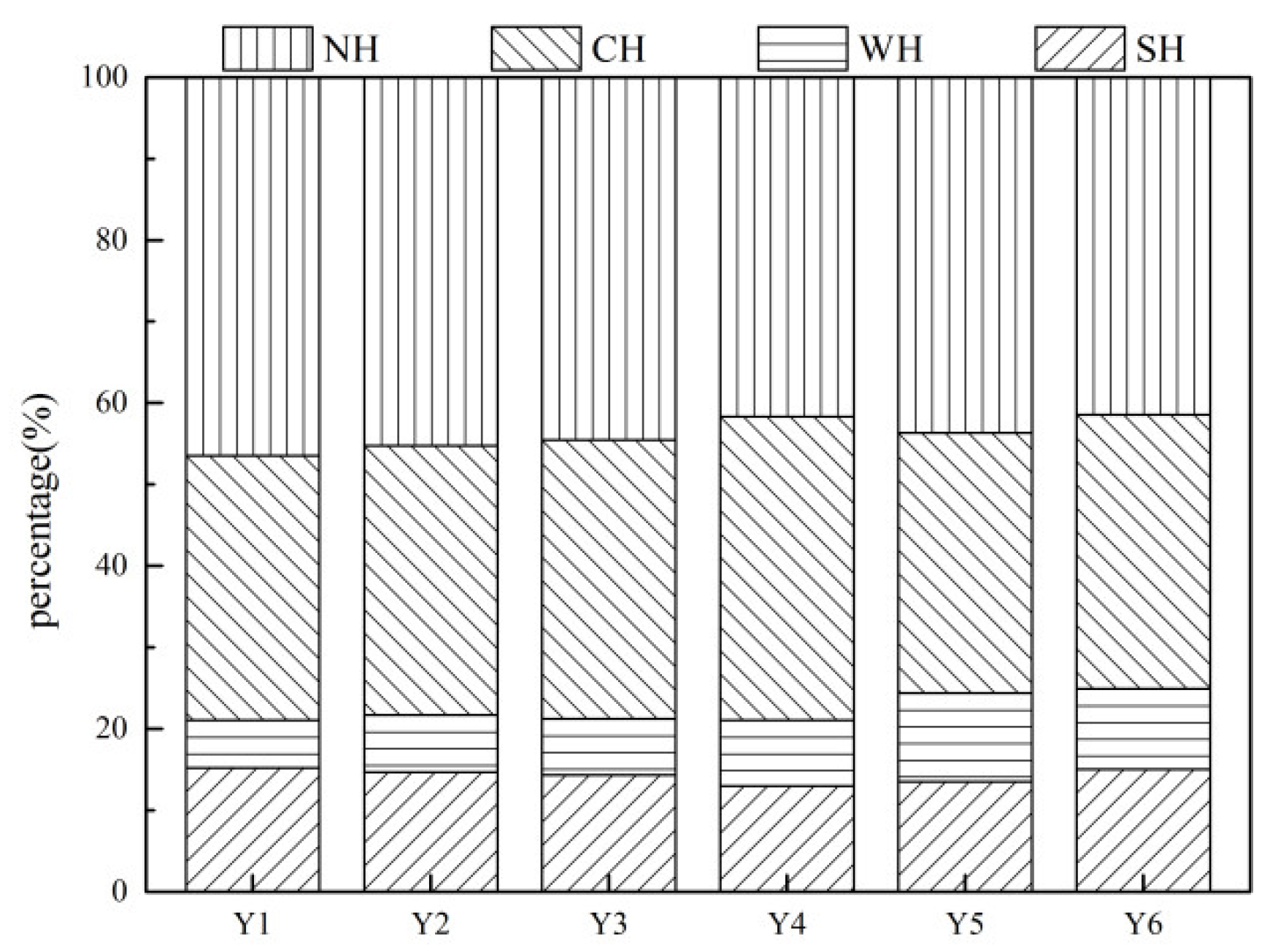
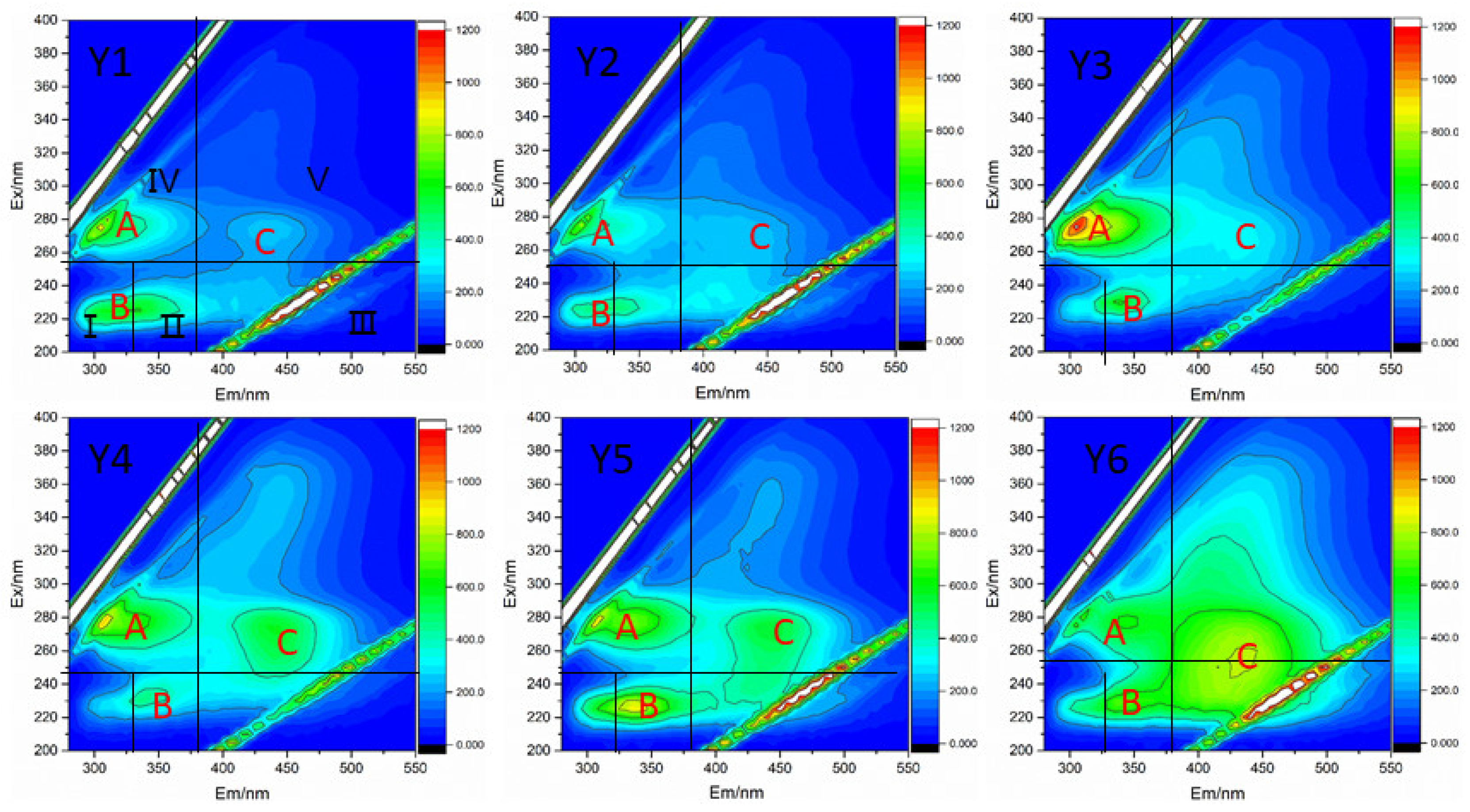
| Region | Substance | Ex/EM Wavelengths (nm) |
|---|---|---|
| I | Tyrosine-like proteins | 200–250/280–330 |
| II | Tryptophan-like proteins | 200–250/330–380 |
| III | Fulvic acid-like organics | 200–250/380–550 |
| IV | Soluble microbial byproducts | 250–400/280–380 |
| V | Humic acid-like organics | 250–400/380–550 |
| PI,n | PII,n | PIII,n | PIV,n | PV,n | PIII + V,n/PI +II + III,n | |
|---|---|---|---|---|---|---|
| Y1 | 28.46 | 33.34 | 13.71 | 13.99 | 10.51 | 0.32 |
| Y2 | 25.85 | 31.51 | 17.24 | 15.67 | 9.74 | 0.37 |
| Y3 | 19.44 | 30.69 | 11.58 | 21.64 | 16.65 | 0.39 |
| Y4 | 13.24 | 40.65 | 12.65 | 15.32 | 18.15 | 0.44 |
| Y5 | 21.07 | 33.33 | 16.00 | 14.37 | 15.23 | 0.45 |
| Y6 | 13.72 | 29.76 | 23.09 | 11.95 | 21.48 | 0.80 |
© 2019 by the authors. Licensee MDPI, Basel, Switzerland. This article is an open access article distributed under the terms and conditions of the Creative Commons Attribution (CC BY) license (http://creativecommons.org/licenses/by/4.0/).
Share and Cite
Yang, X.; Wei, X.; Xu, X.; Zhang, Y.; Li, J.; Wan, J. Characteristics of Dissolved Organic Nitrogen in the Sediments of Six Water Sources in Taihu Lake, China. Int. J. Environ. Res. Public Health 2019, 16, 929. https://doi.org/10.3390/ijerph16060929
Yang X, Wei X, Xu X, Zhang Y, Li J, Wan J. Characteristics of Dissolved Organic Nitrogen in the Sediments of Six Water Sources in Taihu Lake, China. International Journal of Environmental Research and Public Health. 2019; 16(6):929. https://doi.org/10.3390/ijerph16060929
Chicago/Turabian StyleYang, Xiaofan, Xueyu Wei, Xiaoping Xu, Yu Zhang, Jincheng Li, and Jie Wan. 2019. "Characteristics of Dissolved Organic Nitrogen in the Sediments of Six Water Sources in Taihu Lake, China" International Journal of Environmental Research and Public Health 16, no. 6: 929. https://doi.org/10.3390/ijerph16060929
APA StyleYang, X., Wei, X., Xu, X., Zhang, Y., Li, J., & Wan, J. (2019). Characteristics of Dissolved Organic Nitrogen in the Sediments of Six Water Sources in Taihu Lake, China. International Journal of Environmental Research and Public Health, 16(6), 929. https://doi.org/10.3390/ijerph16060929




